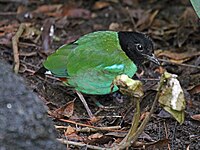Pitta sordida




































Not Threatened
16 – 19 cm; 42 - 72 g. Adult of nominate race has entire head, including chin and throat, black, upperparts dark green, uppertail-coverts and large patch on wing-coverts rurquoise-blue; flight-feathers black, secondaries edged green, variable white patch on primaries; tail black, tipped blue-green; breast and flanks blue-green, occasionally stronger blue, large black central belly patch, lower belly and undertail-coverts red; iris dark brown; bill black; feet pale brown to pinkish with silver-violet tinge to grey-blue. Female is sometimes slightly duller. Dusky stripes found on both green and blue upperparts and green under parts of 40% of 439 adults examined (both sexes, all races). Juvenile is duller than adult, red-brown forehead, dull greenish above, conspicuous white wing-covert band, white throat, buffy-orange breast becoming buff below, orange tip and base of bill, greyish-pink feet. Races differ mainly in general darkness of plumage, crown colour and amount of white in wing: palawanensisi is very like nominate but a shade darker, juvenile darker brown below; cucullata is large, long-winged, has forehead to nape red-brown, plumage rather pale in general, less black on belly; abbotti resembles last but darker, more olive above, bluer below, less white in wing, smaller blue rump and wing patches; bangkana has variable amount of dark brown on crown; mulleri has entirely black head, black on belly, longer legs; forsteni is larger than previous, with longer wings and contour feathers, green tail, no wite in wing; novaeguineae is darker, dark green above, little of no blue on rump, green tail, golden yellow-green breast, blue-green sides, black belly patch, dark blue lower flanks, only little white in wings; goodfellowi is slightly smaller and darker than last; rosenbergii resembles last but more blue on rump, tail black, much darker below, breast washed dark blue without glittering breastband, more extensive dark ultramarine-blue on flanks, red lower breast to vent, no black on belly; mefoorana differs from previous in having glossy silver-blue upper breast, black belly patch.
16 – 19 cm; 42 - 72 g
Taxonomy: Recently treated as forming a superspecies with P. superba and P. maxima, sometimes also including P. steerii, but morphological differences seem too great for this treatment; probably closest to last of those three. The four New Guinea races novaeguineae, from which described race hebetior (from Karkar I, off N Papuan coast) considered indistinguishable, mefoorana, rosenbergii and goodfellowi are geographically isolated from others and show several plumage differences from them; may represent a separate species. Race palawanensis possibly better treated as synonymous with nominate. In original description, race mulleri was written thus (without umlaut), so this is correct spelling rather than muelleri. Twelve subspecies recognized. (source: Handbook of the Birds of World)
Subspecies and Distribution:
- cucullata Hartlaub, 1843 - Himalayan foothills from N India E to N Myanmar, S China (S Yunnan) and N Vietnam (W Tonkin), S to N Bangladesh, Thailand, S Laos and Cambodia; migrates S as far as Sumatra and Java.
- abbotti Richmond, 1902 - Nicobar Is.
- mulleri Bonaparte, 1850 - extreme S Thailand, N Peninsular Malaysia, Sumatra, W Java, Borneo, and W Sulu Is (Sibutu).
- bangkana Schlegel, 1863 - Bangka I and Belitung I. sordida (Statius Muller, 1776) - Philippine Is (except Catanduanes, Masbate, Panay, and Palawan group), including Basilan and Sulu Is (Jolo, Tawitawi).
- palawanensis Parkes, 1960 - W Philippines (Calauit, Busuanga, Culion, Palawan, Balabac).
- sanghirana Schlegel, 1866 - Sangihe I.
- forsteni Bonaparte, 1850 - N Sulawesi.
- novaeguineae S. Müller & Schlegel, 1845 - New Guinea, including W Papuan Is.
- mefoorana Schlegel, 1874 - Numfor I, in Geelvink Bay.
- rosenbergii Schlegel, 1871 - Biak I, in Geelvink Bay.
- goodfellowi C. M. N. White, 1937 - Aru Is, off S New Guinea.
Wide range of habitats occupied: all types of forest, especially primary riverine forest, secondary forest with heavy understorey or scrub, wet or dry forest, also peatswamp-forest, dense bamboo jungle, overgrown rubber or coffee plantations, various other commercial plantations (e.g. coconut, nutmeg, Albizia), orchards and old gardens, forest clearings with mustard or rice cultivations, forest patches on broken grassland, even mangroves and sago swamps. Occasionally in unusually open habitats on migration. To c. 2000 m in India; mostly in lowlands in SE Asia, but to 915 m on migration; to 500 m in Sumatra, 650 m in Sulawesi and 1000 m on the Philippines; found at up to c. 500 m in New Guinea, locally to 1200 m.
Insects of many kinds, e.g. beetles, ants, termites (Isoptera), Orthoptera, cockroaches (Blattodea), bugs (Hemiptera), various larvae; also earthworms and snails, and once a leaf found in a stomach. forages on forest floor among dead leaves, often two birds feeding 5 . 30 m apart; probes among litter, flicks and scrapes aside leaves.
Eggs in Apr-Aug in India; in May-Oct in SE Asia, Dec-Apr in Borneo, Feb-Jun in Sulawesi and Dec-Jun in New Guinea; few records from Philippines suggest season May-Jun, but on Tawitawi (Sulu Is) a cutch found in third week Jul. Nest, built by both sexes, a football-sized flattened dome made of twigs, dead and skeletonized leaves, plant fibres, rootlets and moss, lined with finer material, often with a short “walkway” of twigs leading up to side entrance, placed on forest floor. Clutch 2 – 5 eggs, usually 3 – 4, white with brown and underlying greyish spots, average c. 27x21 mm (cucullata); both sexes incubate, period 15 – 16 days; both also feed and tend chicks, male perhaps taking greater share of duties; young fledge at c. 16 days, and in captivity where able to feed themselves c. 12 days later. Two individuals were recaptured 30 and 38 months respectively after they had been ringed.

























